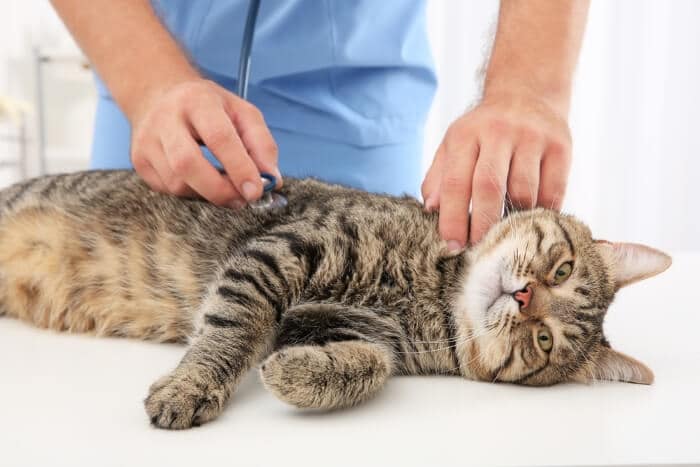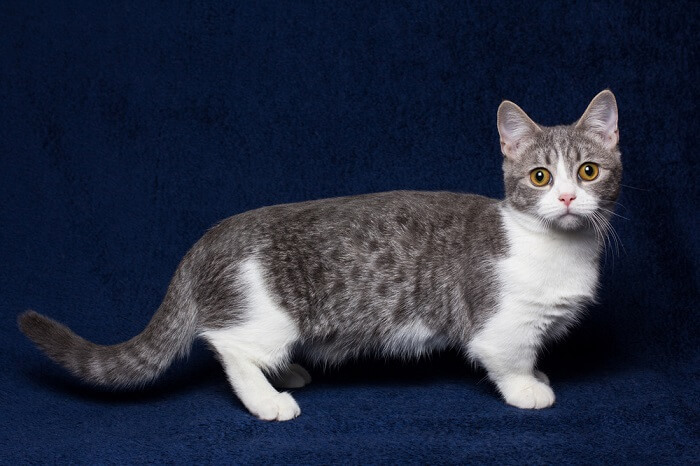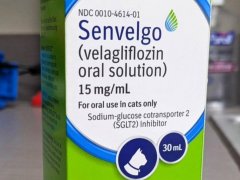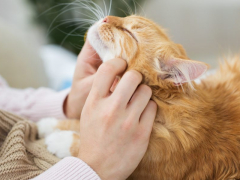
Methimazole, for which common brands include Felimazole and Tapazole, is an oral medication commonly used in veterinary medicine to treat cats with hyperthyroidism. In this article, you’ll learn what methimazole is, how it works, side effects to monitor for, and some frequently asked questions.
Methimazole for Cats Overview

About Methimazole for Cats

Methimazole is classified as an antithyroid medication. Essentially, it inhibits the synthesis or production of thyroid hormone secreted by the thyroid glands.
Methimazole is a very common and valuable medication for use in treating cats with hyperthyroidism where the thyroid glands produce too much thyroid hormone (T4), leading to chronically debilitating effects on the body.
One brand of methimazole, called Felimazole and manufactured by Dechra Pharmaceuticals, is FDA approved for use in cats. Tapazole, a human brand, is commonly used off-label in cats. There are also many generic forms of methimazole.
Although a couple of treatment methods for hyperthyroidism are available, including methimazole, iodine 131 treatment, surgical removal of the overactive thyroid gland, and a prescription diet, methimazole’s greatest benefit is that it is a very inexpensive way to get fairly quick control over the disease.
What Does Methimazole Do for Cats?

Feline hyperthyroidism is a very common disease in older cats. It is considered the most common endocrine disease that afflicts older cats.
Also Read: Best Cat Food For Hyperthyroidism
An endocrine disease is one that concerns glands within the body that produce hormones. In the case of hyperthyroidism in cats, the glands are producing too much T4 and T3 thyroid hormones.
The effect that too much thyroid hormone places on the body can vary from cat to cat, but is generally widespread throughout the body. High thyroid levels increase metabolism, essentially putting a kitty’s body on overdrive.
Classically hyperthyroid cats are usually at least 10 years of age or older, and develop a ravenous appetite coupled with weight loss.
Hyperthyroidism in cats is most often caused by a benign tumor of the thyroid glands called an adenoma. Truly cancerous malignant tumors of the thyroid gland are fortunately considered very rare in cats, making medical management very feasible.
Methimazole blocks the synthesis and release of thyroid hormone from the thyroid gland, thereby controlling overproduction and the effects of the disease. The amount of hormone production that is blocked depends on the dosage used and each individual cat. In this way however, methimazole is a medication that can only manage, but not cure, hyperthyroidism.
Side Effects of Methimazole for Cats

If cats experience side effects from methimazole they usually appear within the first three months of use.
Many cats tolerate methimazole well, but there are some more common and uncommon adverse effects to be aware of, which most often occur within the first three months of methimazole use. The most common side effects include vomiting, loss of appetite/anorexia, and excessive tiredness/lethargy.
Gastrointestinal upset effects occur in about 10% of cats. In some cats, this may be related to the bitter taste of the tablet form, and hiding it in food or a treat may help.
Other, more serious side effect abnormalities fortunately occur less commonly. Blood disorders, like clotting/platelet issues, bleeding, and low cell counts occur in about 4% of cats.
Intense facial itching, termed pruritis, may occur in 2% to 3% of kitties, and is often seen more quickly, within the first three weeks of treatment.
Other rare but serious effects can include liver disease and an immune-mediated disorder, both of which occur in less than 2% of cases.
Even more rarely, a neuromuscular disorder called myasthenia gravis has been seen.
Because older cats are more often affected by hyperthyroidism, other diseases may sometimes already be present that can complicate treatment. The most common is kidney disease. When hyperthyroidism is present, it drastically increases the filtration rate in the kidneys, which can mask underlying kidney dysfunction.
This dysfunction may only be noted after starting the medication, as the filtration rate in the kidneys slows down with the normalizing metabolic rate. This is one primary reason that lab work rechecks are commonly needed to monitor organ function.
In cats with moderate or severe kidney disease already present, any treatment for hyperthyroidism should be carefully discussed, as therapy is likely to make kidney disease worse. In the author’s experience, treatment even in cats with mild kidney disease who are newly diagnosed as hyperthyroid, should be approached cautiously.
Methimazole may cause complications in kitties with other disorders that may be present, including diabetes mellitus, liver disease, or any pre-existing blood-related disorders or disorders of the immune system.
Several types of medications may interact with methimazole. It’s very important to make your veterinarian aware of any other medications or supplements your kitty is currently taking when discussing use of methimazole.
Overdoses of methimazole are most likely to temporarily induce the most common adverse effects, like GI upset and lethargy. Effects on the liver may also occur, as well as blood disorders like anemia and low platelet count. Effects may largely depend on the dose of methimazole and any other diseases a kitty may also have.
If you are ever concerned that your kitty may have developed side effects while using methimazole, or received an overdose of the medication, make sure to contact your veterinarian, the ASPCA Animal Poison Control Center (1-888-426-4435), or Pet Poison Helpline (1-855-764-7661) for further advice.
In humans, methimazole is considered a teratogen, meaning that it can cause birth defects in a developing fetus. Pregnant women or women who may become pregnant, should wear gloves when handling methimazole, as well as the litter or any bodily fluids (i.e., urine or vomit) from treated cats.
In cats that do develop digestive upset side effects from methimazole, changing to the topical transdermal form may be an option, as stomach irritation by the tablet is bypassed. In cats that develop any of the more serious side effects where methimazole needs to be discontinued, other treatment modalities for hyperthyroidism, like iodine-131, surgery, or a prescription diet would be needed to manage the disease.
Methimazole for Cats Dosage

The FDA-approved brand name product Felimazole (methimazole) is a tablet given by mouth.
Per the label for the FDA-approved product Felimazole for cats, the dose for methimazole starts at 2.5 milligrams per cat every 12 hours. The dose is then titrated/adjusted depending on recheck lab work after three weeks. The dose should only be adjusted in 2.5-milligram increments.
The maximum total dose for Felimazole is 20 milligrams per day divided in two 12-hours doses of not more than 10 milligrams each.
Many cats with hyperthyroidism may be regulated well at 2.5 milligrams twice a day, though adjustments may be needed, which is why recheck lab work is so important, especially when starting out.
In cats that don’t tolerate the tablet form of methimazole, either because of digestive upset effects, or a kitty parent having difficulty at home giving a tablet to their cat, oral liquid and topical transdermal preparations can be formulated through compounding pharmacies.
While easier to administer, it is important to note that the transdermal preparation often does not work as efficiently or as well as the oral form, often taking longer to reach levels of control, and requiring higher doses.
The transdermal form should also always be applied by a human with gloves so as to prevent absorption of the medication through their own skin by accident.
For pet parents considering one of the more curative treatment options for hyperthyroidism, like surgical removal of the overactive gland or iodine-131 treatment, a short-course of methimazole is still often prescribed to both get symptoms under control until the procedure, as well as to ensure control is possible and that secondary kidney disease does not develop after thyroid function returns more to normal.
Conclusion

Methimazole is a very commonly prescribed medication for cats with hyperthyroidism. Its benefits are that it works within only a couple of weeks to control signs of the disorder, and it is very inexpensive.
Side effects are generally less common, but are well-documented and possible. However, since other treatment methods may be less reliable (prescription diet) or prohibitively expensive (surgery and iodine-131 treatment), methimazole still remains the go-to medication for management of this common condition.
Drug Dosing Disclaimer: We are only able to provide doses for medications that are FDA approved for use in cats and only as the label guidelines dictate. For medications that are used off-label we can only provide guidelines and safety information for use. Safe and appropriate dosing for off-label medications can only be determined by a primary care veterinarian.
We encourage you to work with your veterinarian to determine if a particular medication is appropriate for your cat. Changing or adjusting a dose for your cat on your own without consulting with a veterinarian can carry risk. We do not encourage use of medications prescribed for human use in pets without first consulting with a primary care veterinarian.
Frequently Asked Questions
What are the side effects of methimazole for cats?
There are several potential side effects that can be seen with methimazole in cats. The most common include digestive upset like vomiting and poor appetite, as well as lethargy.
Sometimes GI upset is due to the bitter taste of the oral tablet, and may be remedied by finding a way to hide the taste or getting the medication compounded into a flavored form.
More serious side effects that are less commonly seen with methimazole include blood disorders like low platelets counts and anemia, liver disease, severe facial itching, and autoimmune disease.
Fortunately, in many cases, these effects will reverse when the medication is discontinued. But unfortunately in these cases, use of methimazole in any form must typically be fully discontinued, and other treatment methods for hyperthyroidism, like a prescription diet, surgery, or iodine-131 treatment, must be pursued instead.
How long can a cat live on methimazole?
This varies, but on average a cat may be expected to live anywhere from two to five years with hyperthyroidism being managed with methimazole.
Variability in this estimate can be due to several factors. Younger cats diagnosed earlier with the disease may have a longer life expectancy than a much older cat who is diagnosed after effects of the disease (such as weight loss, blood pressure, heart dysfunction, kidney disease) have already taken their toll on the body.
Cats with pre-existing diseases, like kidney disease, diabetes, or primary heart disease may also fare less well with treatment of hyperthyroidism in general.
According to a study published in 2006 in the Journal of the American Veterinary Medical Association that followed about 170 cats, about one-third treated with methimazole alone lived for two years on average. Another one-third treated with iodine-131 lived for four years on average, while the remaining one-third who were treated first with methimazole and then with iodine-131 lived the longest, at about five years.
Keep in mind that with most cats being diagnosed somewhere between 10 and 15 years of age (12 years on average), these life expectancy estimates are still looking at a cat making it further into later years with a decent quality of life.
How long does methimazole take to work in cats?
Oral methimazole has been found to reach a peak concentration in the body in only 30 to 60 minutes. However, its effect on signs and symptoms of hyperthyroidism do take longer to realize.
The expectation is that three to four weeks after first starting therapy, the effect the starting dose has on thyroid function will be well-represented on bloodwork. If thyroid levels are still high, it is then appropriate to increase the dosage. The dosage should never be increased or decreased based solely on the appearance or signs a cat is showing (unless we’re seeing an adverse effect or toxicity concern).
The effects of hyperthyroidism on the body of a kitty, like weight loss, muscle loss, secondary heart disease, high blood pressure, etc., while typically reversible, will usually take several weeks to change noticeably.
What is the life expectancy of a cat with hyperthyroidism?
Again, as similarly answered above, the outcome can be variable, but is often at least two years in cats with no other diseases complicating things, like kidney disease.
Overall, based on the 2006 study referred to above, the best outcome came from cats first regulated with methimazole who were then treated with iodine-131, who on average lived for five years.
Iodine-131 is considered the ultimate treatment of choice for cats with hyperthyroidism since the treatment only targets the overactive thyroid tissue while preserving normal tissue. While surgery can also be effective, the entire gland is removed, and if any stray overactive thyroid tissue is present (which is called ectopic thyroid tissue), continued signs of hyperthyroidism may continue.
While I-131 and surgery are both considered cures for hyperthyroidism and recurrence of the disease is very rare, they are both more expensive options, leaving long-term management of the disease with methimazole the most viable option for many folks.
It is suspected that management of hyperthyroidism with methimazole over the long term still means that the disease progresses, just at a significantly slower rate, likely owing to the difference in outcome using medical management alone versus pursuing a cure with I-131.







